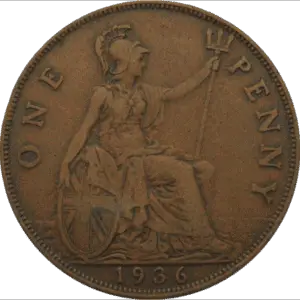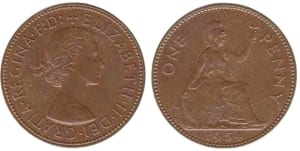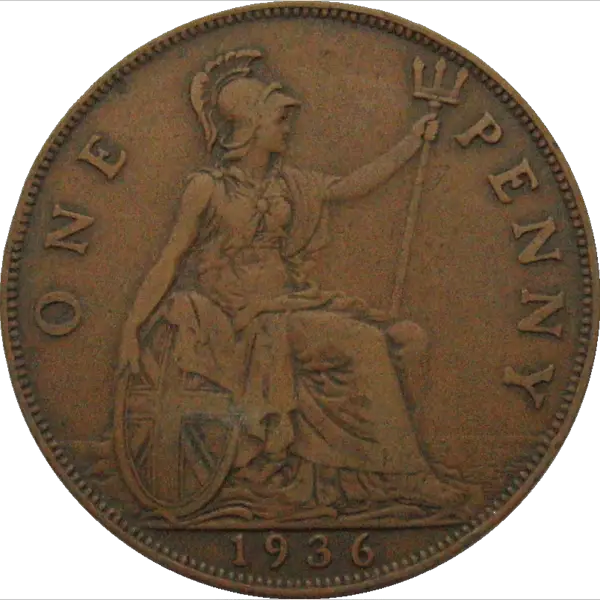The pre-decimal penny was a coin that was issued between 1707 and 1970, before its replacement after decimalisation by the ‘new’ decimal one pence. At the time of its mintage, the pound was split into 20 shillings each worth 12 pence, so one penny was essentially 1/240 of a pound. Before the pre-decimal penny, there was another iteration of the coin, believe it or not, known as the English Penny.

Read more below to learn more about the pre-decimal penny; including its design and how it changed through the years of its circulation.
A brief history of the pre-decimal penny
In 1707, the first year that the pre-decimal penny was issued, the Kingdom of Great Britain was formed. This was formalised under the 1707 Act of Union, which saw England and Scotland merge. This had great significance for the pre-decimal penny, as the Scottish shilling was replaced by the pre-decimal penny.
So, the pre-decimal penny had come into circulation, but what specifications did it have?
Before the Union Act, pennies had been minted in silver. However, as the price of silver continued to rise it was clear that this practice was unsustainable. Silver pennies stopped being minted for general circulation in 1660 but continued to be produced for Maundy money.
Maundy money refers to money that was given out during an event known as the Royal Maundy. The event itself was inspired by the Bible and was used by the Royal Family to show compassion to the public. It evolved through time and when Henry IV came to the throne he decided to give gifts to his subjects, the amount of which was equal to his age at the time.
It was not until the reign of Charles II that the Monarch gave Maundy money, initially in the form of hammered coins which were given out in 1662. By the 19th century, the Royal Maundy had evolved into solely giving Maundy money as a gift to people.
The tradition improved the perception of the Monarch to the public and allowed them to show compassion.
So, the pre-decimal penny was only minted in silver if it was to be used for Maundy money, but how did its specification change throughout its circulation? Let’s take a look through the 18th, 19th and 20th centuries and how the pre-decimal penny evolved during this time.
18th Century
The pre-decimal penny was issued during the reign of Queen Anne, but only as Maundy money in the years 1708, 1709, 1710 and 1713. It continued to be issued throughout the reigns of George I, George II and George III as Maundy money. However, during the reign of George III there became a shortage of the pre-decimal penny, which led to some merchants privately minting their copper tokens.
This became a huge problem and the Royal Mint had to issue Matthew Boulton to issue copper pennies at his mint in Birmingham in 1797. All of the pennies issued there were dated 1797. During this time coins were minted to contain a value of metal equal to the face value of the coin, which equated to one ounce of copper for a penny.
This led to the nickname of ‘cartwheel’ for pennies issued at this time due to their large size.
19th Century
In the early 1800s, the value of copper had increased which led to more problems with privately issued tokens. The value of the metal contained within a penny had become more than its face value, so it made no sense to use the coin to pay for anything. It became more common to smelt the coin down for the metal content.
In 1816 there was a large re-coinage programme overseen by the Royal Mint to overcome the issues with the penny. There were large amounts of silver and gold used to issue new coins, and in 1817 an Act of Parliament passed which added large penalties to those caught privately minting coins or tokens.
It wasn’t until 1860 however that the decision to change the metal used for the penny was made. Copper pennies were no more, as bronze was chosen to be used to make pennies. The decision was also made to no longer use an amount of metal equal to the face value of the coin to make sure that the same problems were not encountered again.
20th Century
In the 20th century, the bronze penny continued to be minted with a specification of a diameter of 10.86mm and a weight of 9.45g. The penny was issued every year in both Queen Victoria and King Edward VII’s reigns. It was not until 1923, during George V’s reign, that the penny was not minted. This continued for a 3-year gap and happened alongside a change in the composition of the penny to 95.5% copper.
Every year after the 3-year discontinuation in George V’s reign the penny was issued, with the most crucial year for coin collectors being 1933.
The 1933 Pennies
In 1933 there was no demand for any more pennies to be minted as so many had already been issued previously. The Royal Mint had received requests to produce a small number of pennies to be placed under the foundations of certain buildings that were erected that year. There are 7 known examples of these pennies, making them extremely rare. One of these was stolen from a Church in Leeds, with others in private hands or located in museums.
Alongside these 7 pennies, there were also 4 ‘pattern’ pennies produced by designer Andre Lavillier. A pattern coin is essentially a coin issued by the Royal Mint to trial a new design, and given that only 4 of these 1933 pattern coins are known to exist, they are incredibly valuable. In an auction in London in 2016 a genuine 1933 pattern penny sold for £72,000!
Edward VIII and George VI
There are a small amount of Edward VIII pennies produced as pattern coins in existence, but due to his abdication, these are the only pennies from this era.
Pennies were not minted every year of George VI’s reign, primarily due to the economic impact of World War Two. More specifically between 1941 and 1943, there were no pennies minted at all, and in 1951 there was only 120,000 of them minted.
The 1950s
There were so many pennies in circulation by the 1950s that there was no longer a need to produce any more. As previously mentioned only 120,000 were produced in 1951, and there were no more issued into circulation until 1961.
There are still however pennies from this era, as in 1953 there were 1,308,400 pennies issued for collectable coin sets to celebrate the new Monarch Queen Elizabeth II.
Alongside these collectable pennies, there was also at least one penny issued in 1954. This coin was part of an experiment by the Royal Mint into new designs for a portrait of the new Queen. There are 6 uniface versions of these experimental coins, 2 of which in the British Museum and the other 4 in the Royal Mint Collection; but there is thought to only be one complete coin from this year.

The 1960s
As decimalisation was decided to happen in 1971, the pre-decimal enjoyed its last few years of circulation in the 1960s. Pennies were struck right until 1970, with those produced after 1967 still having the date of 1967 inscribed on them. In 1970 750,476 pennies were struck for souvenir sets only, marking the last production of the pre-decimal penny as we know it.
How much are pre-decimal pennies worth?
In terms of the 18th and most of the 19th century, giving a broad answer for the value of a penny from this time is incredibly difficult. This is mainly because there were many different versions of the penny produced during this time including privately minted tokens, which means there is not a specific estimate of value for a penny from this range.
Towards the end of the 19th century in 1860 when the bronze specification was issued it becomes much easier to indicate a rough estimate for the value of a penny. This is because the specification of the pennies from this era remained the same for more than 100 years, meaning the value is much more stable. Remember that we are not including ‘special’ editions of the penny such as the 1933 or 1954 editions, but rather the standard circulating bronze penny.
As an estimate, a pre-decimal bronze penny will look to sell for between £1 and £3 depending on the quality.
This estimation is based on hundreds of sold values on eBay and as such represents what you can expect to sell your penny for. If you think you have a rare specimen then please look into contacting a specialist dealership.
How has the design of the pre-decimal penny changed?
The pre-decimal penny always depicted a portrait of the Monarch of the time on the obverse, like all other British currency.
The silver pre-decimal penny featured a reverse design of a crowned I, which remained until the issue of the copper penny. The design of the crowned ‘I’ changed slightly through the 18th century with the design of both the crown and the letter ‘I’ altering slightly.
When the copper pre-decimal penny was issued the reverse design was changed completely to the iconic image of Britannia. Different variations of the design were used during this time but all of them featured Britannia on the reverse with a portrait of the monarch of the time on the obverse.
This trend would continue into the bronze penny until decimalisation. All bronze pennies also feature Brittania on the reverse with a portrait of the monarch on the obverse.
